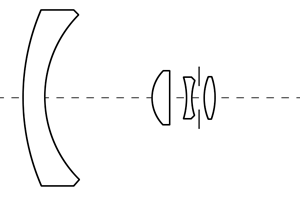The term retrofocus (also: retro-focus) refers to an approach to designing wide-angle lenses for SLR cameras. The name ‘retrofocus’ was popularized by Angenieux in the naming of their 1950 35 mm focal length wide-angle.
Design-wise the retrofocus lens is akin to a reversed telephoto lens, in that it uses one or several negative lenses or lens groups at the front of a lens to increase the back focal distance of the lens.

(Another early representative of the retrofocus design)
Initially the retrofocus lenses were designed in the 1930s for color cinema cameras which needed to make room for a 3-way beam splitter between lens and film(s). While neither Angenieux (Retrofocus R1; 35 mm f/2.5; 1950) nor Carl Zeiss Jena (Flektogon; 35 mm f/2.8, 1949) actually developed the first retrofocus lens for still cameras (that honour should go to Kingslake and Stevens at Kodak for the WA Ektanar 35 mm f/3.5; 1941), they did play a central role in the wide availability of retrofocus lenses.
« Back to Glossary Index